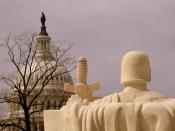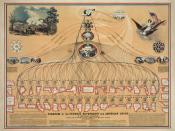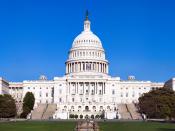Checks and Balances
The U.S government has a built in "check and balance" system in the Constitution. This system was built so that one branch of the government could never become too powerful. Each branch is controlled by the other two.
The power of the Executive branch is in the President, who is Commander in Chief of the Armed Forces. The President appoints the Cabinet and oversees the various agencies and departments of the federal government. The Presidential candidate must be a natural-born citizen of the United States, be at least 35 years of age, and have resided in the United States for at least 14 years. Once elected, the President serves a term of four years and may be re-elected only once. The re-elected term is called a lame-duck term because after eight years in office the President can not be re-elected for the next consecutive term.
The Judicial branch hears cases that challenge or require interpretation of the laws of the land.
It consists of the Supreme Court and the lower federal courts. Appointees to the federal bench serve for life or until they voluntarily resign retire or are impeached for wrong doing by the congress. The Supreme Court is the most visible of all the federal courts. It is the highest court in the land and it's decision can not be appealed on any case brought before it . Congress, rather than the Constitution, determines the number of Justices who can serve in the federal and Supreme Courts. The Court has been composed of one Chief Justice and eight Associate Justices. Justices are nominated by the President and confirmed by the Senate.
The Legislative branch of the federal government consists of the Congress, which is divided into two houses; the House of Representatives and the Senate.


